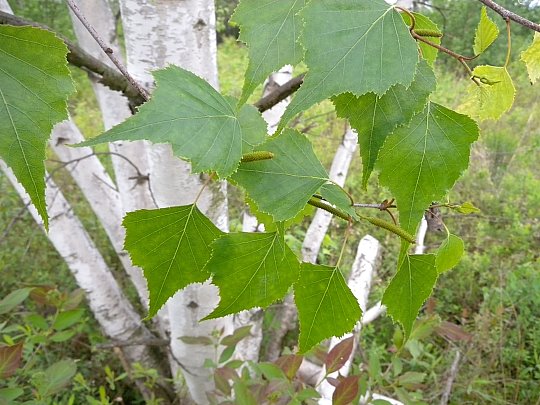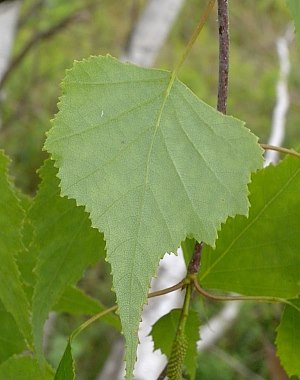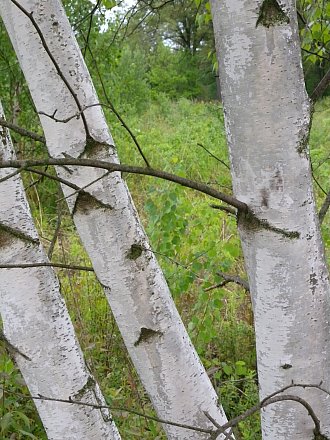
Gray Birch is monoecious, producing separate male (staminate) and female (pistillate) catkins on the same tree. Solitary male catkins (rarely 2 catkins) up to 3" long occur at the tips of twigs; these catkins have a tendency to droop. Each male catkin consists of numerous male florets and floral bracts. Each male floret has 2 stamens, an insignificant calyx, and no corolla; male florets occur in groups of 3 behind floral bracts that are cordate-orbicular in shape. Erect female catkins about 1/3" (8 mm.) long occur among the new leaves of twigs. Each female catkin consists of numerous female florets and floral bracts. Each female floret consists of a somewhat flattened ovary with a pair of styles at its apex; female florets occur in groups of 2-3 behind floral bracts that are 3-lobed. The blooming period occurs from late spring to early summer and lasts about 1-2 weeks. Afterwards, female catkins become about 2/3" (16 mm.) long and droop downward as they mature. The samaras (winged seeds) are distributed by the wind during late autumn or winter. The seed bodies of the samaras are ellipsoid to obovoid and somewhat flattened. Each samara has a pair of membranous wings that are more wide than the seed body. The root system is shallow and branching.

Cultivation: The preference is full sun, moist to dry-mesic conditions, and sandy soil. This tree develops rapidly, but it is short-lived and prone to storm damage.
Range & Habitat: Gray Birch is a rare native tree in Illinois, where it is found in the NE section of the state (see Distribution Map). Some populations of Gray Birch in Illinois may be naturalized descendants of cultivated trees. It is more common further to the east and northeast. Habitats include burnt-over areas of sandy woodlands and sandy savannas, scrubby sand prairies, thickets, banks of streams, and abandoned sandy fields. Gray Birch is a pioneer tree that depends on wildfires and other kinds of disturbance to maintain itself in these habitats.
Faunal Associations: Many kinds of insects feed on the leaves and catkins, suck plant juices, or bore through the wood of Gray Birch and other birches (Betula spp.). These insects include: caterpillars of the butterflies Nymphalis antiopa (Mourning Cloak) and Nymphalis vau-album j-album (Compton Tortoiseshell); caterpillars of such moths as Acronicta betulae (Birch Dagger Moth), Drepana arcuata (Masked Birch Caterpillar), Lithophane hemina (Hemina Pinion), Peridea ferruginea (Chocolate Prominent), and Pero morrisonaria (Morrison's Pero); the larvae of Arge pectoralis (Birch Sawfly), Croesus latitarsus (Dusky Birch Sawfly), and Dimorphopteryx melanognathus (Fringed Birch Sawfly); Euceraphis punctipennis (European Birch Aphid) and the leafhopper Erythridula praecisa; Kleidocerys resedae (Birch Catkin Bug); the leaf-footed bugs Elasmostethus interstinctus and Elasmucha lateralis; Altica betulae (Birch Flea Beetle) and the leaf beetle Scelolyperus meracus; the wood-boring larvae of Agrilus anxius (Bronze Birch Borer) and Xylotrechus quadrimaculatus (Birch & Beech Girdler). Vertebrate animals use birch trees as a source of food and protective cover. Among birds, the Ruffed Grouse feeds on the catkins and buds of birches, while the Pine Siskin and Black-Capped Chickadee eat the seeds. The Yellow-Bellied Sapsucker drills holes in the thin bark of these trees to feed on the sap. Beavers feed on the bark and wood, while White-Tailed Deer use the twigs as a source of winter browse.

Photographic Location: A scrubby sand prairie at Kitty Todd Nature Preserve in NW Ohio.
Comments: The wood of Gray Birch is relatively soft and weak, but it is sometimes used to make wooden spools, clothes pins, toothpicks, and other wooden objects. It is also used as firewood and to make paper pulp. Gray Birch is an attractive tree that resembles the commonly cultivated Betula pendula (European White Birch). Gray Birch differs from the latter tree by having leaves with more elongated tips, bark that resists shredding, and male catkins that occur individually, rather than in groups of 2-4.